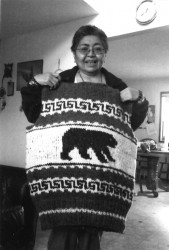Article Origin
Volume
Issue
Year
Canada has officially recognized and honoured the Cowichan sweater and the knitters that make them, as well as Interior Salish basket making, designating them Aboriginal items of national historic significance.
Peter Kent, Canada’s minister of the Environment and minister responsible for Parks Canada, announced the commemorative designations on March 22, along with 11 other Aboriginal persons, places, and events of historic significance.
“[These] designations will bring to life the spiritual, cultural, and physical ties that First Nations have to this country, for both Canadians and visitors to Canada,” Kent said in a statement. “They will give future generations an understanding of moments in time that span the centuries,” he added.
Established in 1919, and supported by Parks Canada, the Historic Sites and Monuments Board of Canada advises the minister of the Environment regarding the national historic significance of places, persons and events that have marked Canada’s history.
This year, all 13 designations were associated with First Nations history.
Although officially recognized as important historic markers, designations don’t hold any responsibility on the government or those honoured, explained Julie Dompierre, director of the Historic Sites and Monuments Board of Canada Secretariat, Parks Canada.
“The designations simply act as an official reminder of what has helped create Canada’s history,” she explained.
“It is an honorific designation,” Dompierre continued, adding that plaques will eventually be situated in various locations or where the people, places, events or items originated.
Each year public nominations flow into the department where they are reviewed. Dompierre says the board sees 70 to 80 designation nominations annually.
Designating the Cowichan knitters and sweater and Nlaka’pamux basket making is something unique to the board.
“Those were wonderful subjects and they were a little bit outside the traditional type of honour,” she admitted. “Neither fit neatly into the site, person and event criteria. But they did fit,” Dompierre continued. “The board recognized the symbolism of the baskets and the Cowichan sweaters, the products produced and the transfer and preservation of traditional knowledge,” she said.
Cowichan First Nation members say they are proud of the recognition.
“I’m very pleased,” said Cowichan Tribes Chief Harvey Alphonse.
“This recognition is long overdue, but I am glad that the Cowichan Sweater and the Cowichan knitters are being honoured at this level,” he added.
“Knitting Cowichan Sweaters is a teaching that has been passed down for generations,” continued Alphonse. “Our people have learned this unique skill from their parents and grandparents. Families pass down unique designs specific to them; it’s a bonding experience for many and a way of sharing our culture and teachings with the younger generations,” he explained.
“It shows Cowichan culture,” agreed Elder and expert knitter, Charlotte Williams.
Williams, 66, has been knitting Cowichan sweaters, toques, vests and scarves since she was 19 when her late husband’s grandmother taught her the craft.
“It [knitting] has helped our people financially,” she said.
While knitting has traditionally been designated woman’s domain, Williams said husbands and brothers in the community would often help process the raw wool; preparing it for use.
Williams says today the gender roles regarding knitting are more relaxed.
“Now some of the men even knit,” she said with a chuckle.
“We’ve made sweaters for all over the world,” Williams adds proudly. Williams’ Cowichan sweaters can be found in Japan, New Zealand and England.
Production of what has come to be known as the Cowichan sweater began in the Cowichan Valley, and grew into an industry that served national and international markets.
Long before the arrival of Europeans, the Coast Salish turned mountain goat wool, dog hair, and plant fibres into woven textiles of great value among the peoples of the Pacific Northwest coast.
Williams has recently retired from her job as a health worker in her community. She says knitting simply provides her with a sense of peace.
“It’s good therapy for me,” said Williams. “I can focus on my knitting and it’s something to do with my hands,” she said.
Also receiving a federal designation is the coiled basket-making of the Interior Salish.
The baskets, made by the Nlaka’pamux, formerly known as the Thompson Indians, are made with coiled cedar root and they emphasize the fine workmanship and decorative techniques of historic basketry. Basket making is central to Nlaka’pamux identity as it articulates a tangible expression of Nlaka’pamux culture and historical memory.
Attempts to contact members of the Nlaka’pamux First Nation were unsuccessful by press time.
However, Lorelie Michaud of the Yale and District Historical Society applauded Ottawa’s decision to designate the basket makers.
“I think they are definitely important and significant. They [the baskets] are part of Canadian heritage,” said Michaud.
Located in Yale in the southern Interior Fraser Canyon, the society holds a modest, yet impressive, collection of 19th century Nlaka’pamux baskets.
Basket making continues among the Nlaka’pamux First Nation as hands-on workshops continue to be offered in the region, Michaud explained.
- 3252 views

